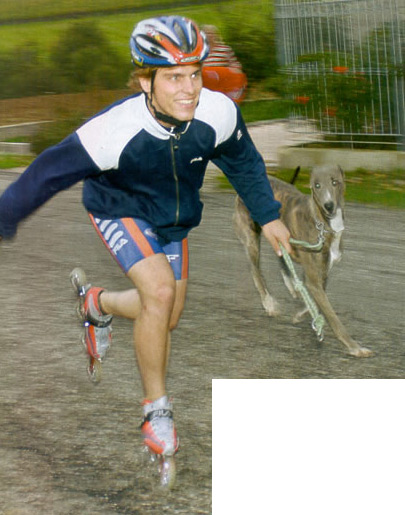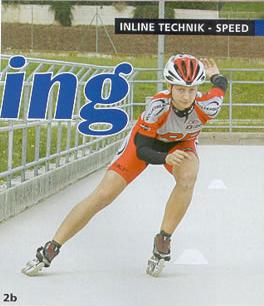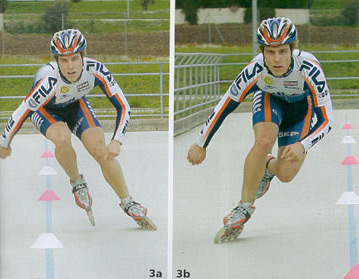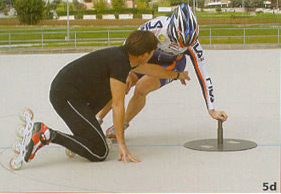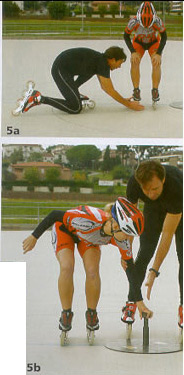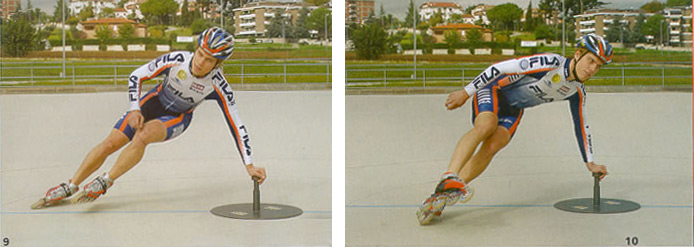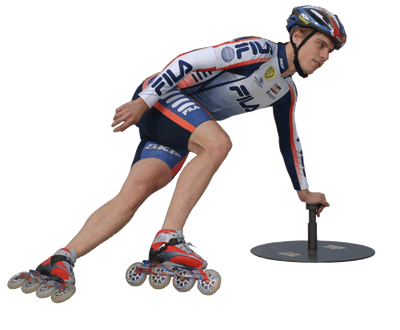<%@LANGUAGE="VBSCRIPT"%>
Abc - italiano
1
- Let’s walk together in this learning experience with the
aim of assisting the coach’s work. The simplicity of the exercises that
I present accelerates the athlete’s learning and raises his self-awareness
on what to do and how to do it. The exercises comply with the execution of
all the in-line skating fundamentals with scientific preciseness. They identify
correct execution in every aspect to achieve “real technique”.
TEACHING KNOWLEDGE = BEST TECNIQUES = MAXIMUM SPEED = ECONOMY OF MOVEMENT
Even
if these two exercises are very simple, the teaching results successful, with
verbal action (explanation during the execution), with sense action (press-touch
or contact with body parts), with kinaesthetic action (feed-back received
by the athlete during exercise).
STRAIGHT-AWAY
RUNNING
3 - Transferring body weight (“running on railroad tracks”)
Aim: to make the athlete aware
of the shifting of the hips from one side to another while variating the angle
of the knee. The body weight must be transferred on a frontal plane in order
to have the best push in the straight-away.
Execution: start with skates
set wider than the hip-bone and knees bended (points B advanced to cover points
A). Transfer body weight from left to right and vice versa trying to line
up the four points of the leg supporting the weight (with bended knee), the
other leg (with extended knee) must obviously not support weight. The skates
must be always kept parallel, “strictly” at the same distance
and on the same line (depth = 0).
Common mistakes: the body weight
is transferred with a movement that is non parallel to the ground, the skates
are not lined up on a frontal plane, and there are continuous modifications
of the distance between the skates.
N.B.: in the next exercise the
athlete, besides having to execute the exercise correctly, will have a new
difficulty: to shift his weight at every pylon (space-time and rhythm coordinative
skill development).
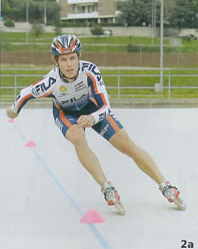


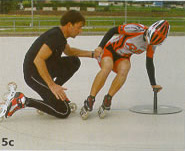
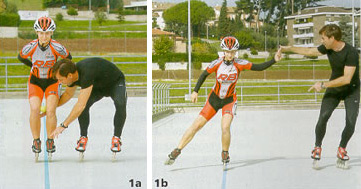

Exercise A:
roll while leaning with your hand on the top, with a fellow skater pushing.
Aim: to keep the acquired correct
posture on the legs and to keep correct body axis inclination.
Execution: see the general indications
on roll-on (aim).
Common mistakes: the lower parts
of the legs are not bended, the outer leg is extended.
CURVE RUNNING
6 - Correct position
and correct body axis inclination.
With this simple and rough tool (“the top”) we can facilitate
conditions so that the athlete can learn the correct position while doing
a curve
first statically and type dynamically. The body axis inclination associated
with a reduced radius of the curve and a low speed produces the right feelings
for pushing and for the correct path with the skates on ground (the athlete
is made aware of the right pushing).
Note well: Do not believe it is easy to keep the position
presented in the following pictures, even while standing still.
Exercise B:
roll while holding a cane over the knees.
Aim: to reduce “the depth”
between the two skates, to keep the hip-bone and the shoulders parallel to
the curve radius.
Execution:
see the general indications on rolling (aim).
Common mistakes: the weight
is placed only on the outside leg, the outside leg moves backwards and thus
the cane is rotates towards the outside of the curve.
Exercise
C: roll while holding a cane behind the knees.
Aim:
to reduce “the depth” between the two skates, to keep the hip-bone
and the shoulders parallel to the curve radius.
Execution:
see the general indications on rolling (aim).
Common mistakes:
the weight is placed only on the outside leg, the outside leg moves backwards
and thus the cane rotates towards the outside of the curve.
7 - Rolling (static decelerating
phase)
Aim: to roll with parallel skates
as wide as the hip-bone, to get a good body axis inclination without interruptions
on the line, to line up the 4 points on the right and on the left of the body,
to line up points A-B-D (lateral view), to equally distribute the body weight
over the two skates, to have the same knee bending, to keep the internal skate
ahead no more than one wheel; to keep shoulders and hip-bone (iliac spines)
parallel to the curve radius.
Execution: try to create different
situations changing speed and curve radius; respect all the executions specified
in the aim.
Common mistakes: to roll with
skates too close to each other, to not line up the points on the frontal and
on the lateral planes, to unload the weight on the outside skate, to advance
the internal skate too much, to turn shoulders and hip-bone towards the inside
of the curve.
8
- Crossover (propulsive dynamic phase)
Aim: to obtain a “continuity”
in alternating left and right leg pushes’; to create a “synchronized
action” between the leg landing and the other leg ending the push; to
stay longer on the internal leg at the curve; “to land” with the
right foot lining up the 4 points on the right side, with the left foot lining
up the 4 points on the left side, “eliminate” rolling on in order
to keep the running speed homogeneous.
Execution: obtain a complete
extension-push of the right leg (see picture) before landing on the left leg,
control body inclination without variations.
Execution: obtain a left leg
complete extension-push (see picture) before landing on the right leg, control
the body inclination without variations.
2
- TEACHING: SKILL AND ENJOYMENT
Two exercises presented in the previous chapter are shown in the pictures:
a) Basic position and weight distribution
b) Single skate in straight-away (searching for the “triangle”
configuration), with the variation of raising the skate from the ground.
4
- Offset slalom pylon push (skates touching the ground)
Aim: (1) to help the athlete
increase body axis inclination starting with skates close to one another,
(2) to use a lateral push also in a curve, (3) to search for the correct body
axis inclination in the straight-away pushing phases, to learn better the
double push and the “progressive dynamic rolling” (distance tests).[foto
2a e 2b]
Execution: bend body with united
skates when at pylon level, then push with the leg far from the pylon, increase
the speed and body inclination (practical advise: lean towards the pylon and
then push).
Common
mistakes: not sufficient inclination of body axis; skates
not united; the extension of the pushing leg is not complete; the pushing
is directed towards the back; there is no weight on the internal skate at
the
end of the pushing phase.
5 - Transfer of body weight and fast pace (propedeutic for speed tests)
The exercise is the same already presented: “the windshield wiper”.
Aim: to create transfer of body
weight as result of legs’ extension-push, to adjust the execution pace
in function of the pylon’s distance.
Execution: use a straight line
on the track. Increase the speed and when at first pylon level stay only on
one leg with the weight distributed on all
wheels
(landing). Begin the lateral extension-push to start the hip-bone transfer;
at the end of the push the following landing must be on the opposite side
of the line (to make a “triangle”). The correct push never permits
to “cut” the line on the ground.
Common mistakes: atterrare quando
la gamba di spinta non è ancora completamente estesa, atterrare nella
stessa parte della gamba di spinta, questo errore porta a “tagliare”
la linea.
ATTENTION:
The hip-bone position during the curve is fundamental for a correct execution
of the rolling and the crossover step (in the picture the coach indicates
the point C, the left iliac spine, to the athlete; this point must be kept
compressed towards the inner part of the curve).
ATTENTION:
you must land on the right leg after the complete extension-push of the left
leg.
Common mistakes:
The most common mistake and the worst one for the pushing efficiency is to
land the right leg when the left push is not yet complete. A further mistake
is to land lining up points A and B (right side) with points C and D (left
side).
9 - To transfer these “made simple” technical exercises
to real situations (training and racing).
At this point the athletes have the basic information of how understand the
techniques. In this itinerary of our learning we presented the in-line skating
technical biomechanical and mechanical concepts (first article),
we illustrated position and awareness exercises
(second article), we demonstrated the propedeutic exercises in order to acquire
and to control fundamentals (this third article). The exercises for the start
will be presented in the fourth article. The coach can now transfer his knowledge,
according to the pupil’s group and to the target he wants to reach,
to each of his pupils in real training and racing situations.
ATTENTION: if during these new
situations the technical model changes or is not reproduced exactly as it
is during the technical exercises, the learning will not be well assimilated,
and future teaching schedules must still provide “a wide space”
for technical lessons.
(nella
foto 5d viene indicato all’allievo il punto 3, spina iliaca sinistra,
tale punto è da tenere “schiacciato” verso l’interno
della curva).
